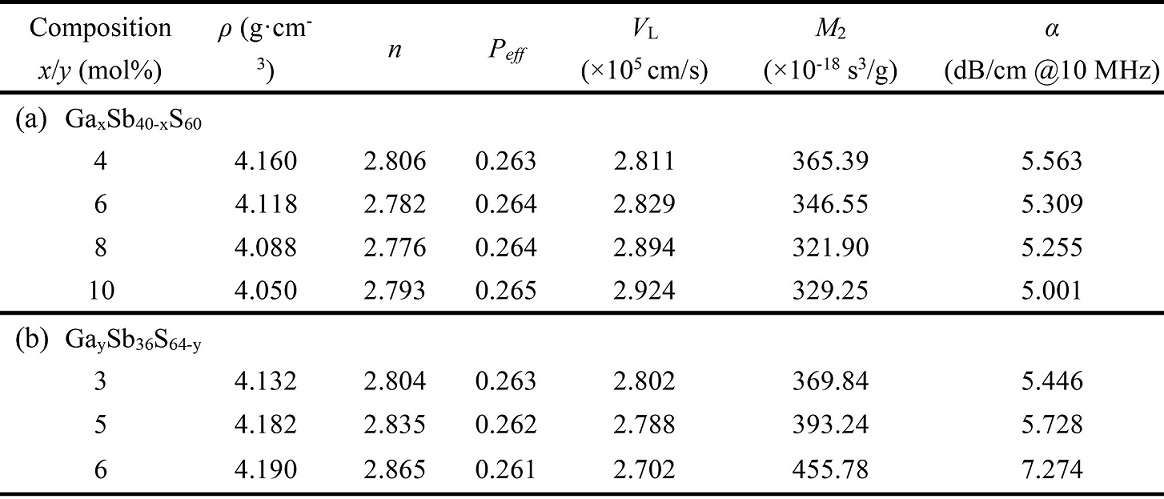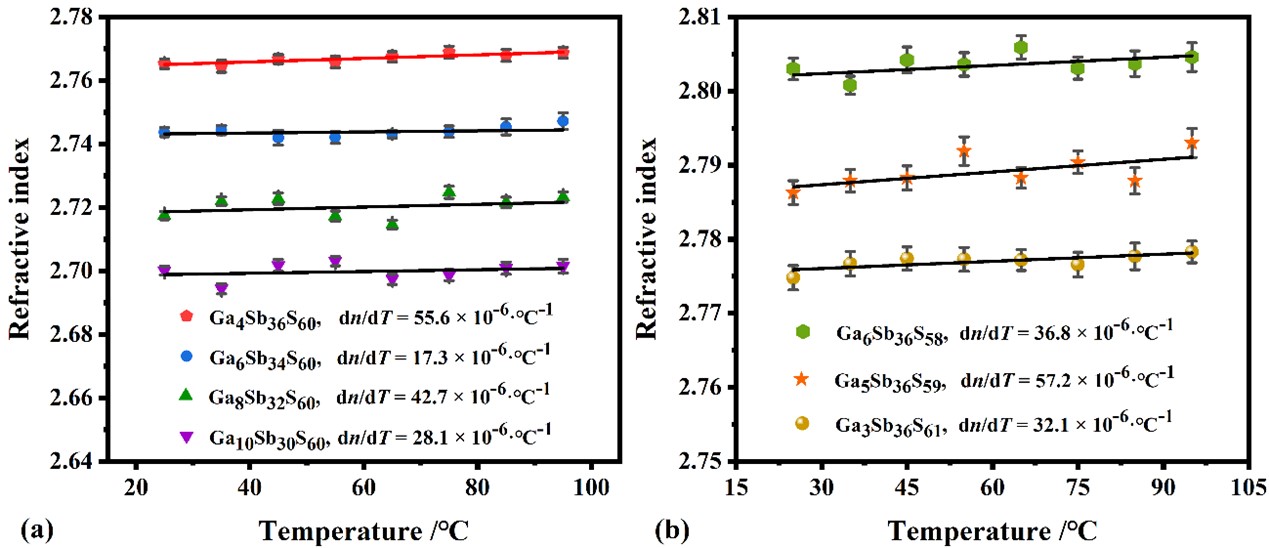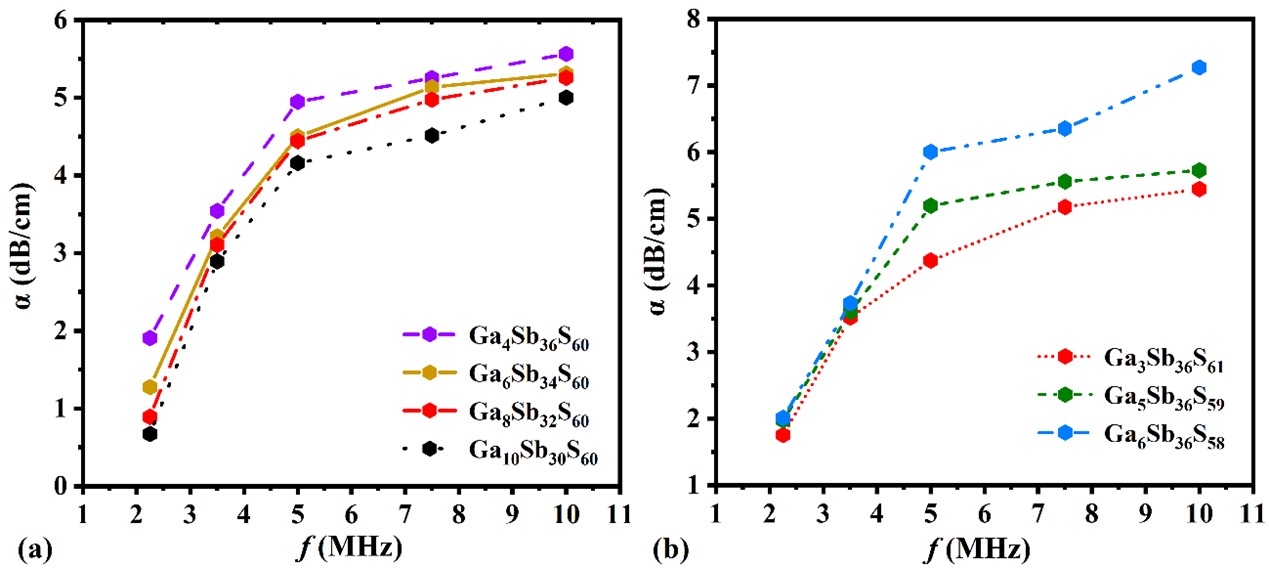Recently, Zenghua Xu (first author), a postgraduate student in our laboratory, and professor Shixun Dai (corresponding author) have published an article entitled “Investigation of the Ga-Sb-S chalcogenide glass with low thermo-optic coefficient as an acousto-optic material” in Ceramics International (Ceramics International. 2022, 48 (15), 21704-21711. https://doi.org/10.1016/j.ceramint.2022.04.144.).
Acousto-optic (AO) devices can quickly and effectively control the intensity, frequency, and direction of laser light, and are widely used in laser resonators, optical signal processing, and optical detection. Chalcogenide glass (ChGs) has become a commonly used medium for AO devices due to its high linear refractive index (2.1-3.5), working wavelength can cover near-to-mid-far infrared band, and its high optical quality. However, from the perspective of actual acousto-optic device design, the high thermo-optic coefficient (dn/dT) of ChGs usually leads to phenomena such as thermal lensing, self-focusing, and laser damage, which makes it difficult to be applied to AO devices modulated by high power laser. Therefore, it is of great significance to study chalcogenide glasses with low dn/dT values as AO media. Currently, a small amount of commercially available ChGs is labeled with dn/dT parameters, but just the value of them at 10 μm is reported. For instance, the dn/dT of AMTIR-6 (As2S3), IG5 (Ge28As12Se60), and GASIR@2 (Ge20Sb15Se65) commercial amorphous ChG glasses from AMTIR, VITRON, and Umicore in the mid-infrared wavelength of 10 μm are 76 × 10−6 /◦C, 91 × 10−6 /◦C, and 58 × 10−6 /◦C, respectively. In addition, there is no report on this parameter in the near-infrared band. In order to develop low-power fiber AO devices operating in the 1.55 μm band, it is necessary to study the dn/dT value of the novel ChGs at 1.55 μm.
In this study, two series of GaxSb40-xS60(x = 4, 6, 8, 10 mol%) and GaySb36S64-y (y = 3, 5, 6 mol%) glasses were prepared and the relationship between their compositional and AO properties was investigated systematically for the first time. Table 1 summarizes the AO parameters of Ga-Sb-S glass. Although the AO figure of merit (M2) of the (a) GaxSb40-xS60 system decreases with the increase of Ga content, the α (@ 10 MHz) and dn/dT of the glasses are lower, reaching a minimum of 5.001 dB/cm and 17.3 × 10-6/℃[Fig. 1(a) and Fig.2 (a)], respectively. For (b) GaySb36S64-y glass with high Sb content, the maximum M2of the Ga6Sb36S58 glass was 455.78 × 10−18 s3/g (as shown in Table 1), which is ~301 times greater than that of fused silica and ~2.5 times greater than that of As2S3 ChGs at 1550 nm. However, Fig. 1 (b) shows the thermo-optic coefficients (dn/dT) of these glasses, and their values varied greatly (32.1 × 10−6 /◦C–57.2 × 10−6 /◦C), and acoustic attenuations (α) at 10 MHz were high, from 5.446 dB/cm to 7.274 dB/cm (as shown in Fig. 2 (b)). The research results provide an important reference for the application of novel chalcogenide glasses in AO devices.
Table 1 Related parameters of M2 for glass samples.

Note: The parameters were obtained at 1.55 μm.

Fig. 1. Variation of the refractive index of (a) GaxSb40-xS60 (x = 4, 6, 8, 10) and (b) GaySb36S64-y(y = 3, 5, 6) glasses with temperature at 1.55 μm wavelength.

Fig. 2. Acoustic attenuation (α) of (a) GaxSb40-xS60 and (b) GaySb36S64-y glass samples at different ultrasonic frequencies (f = 2.25, 3.5, 5, 7.5, and 10 MHz).


